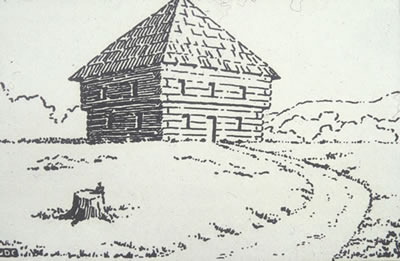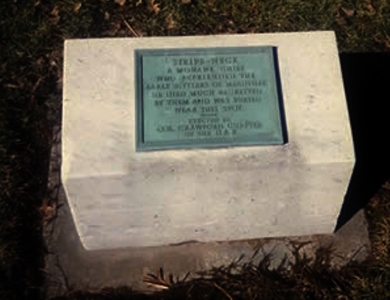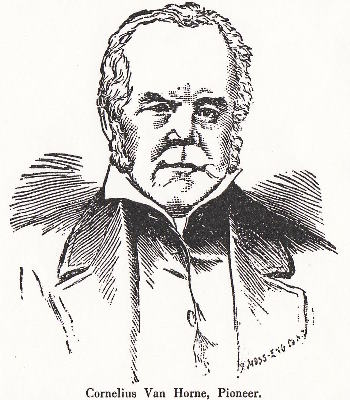DAVID MEAD’S
FRONTIER COMMUNITY
The establishment of Fort Franklin facilitated
expansion of white settlement on the banks of French Creek. Three of
the soldiers involved in its construction would become settlers in
Crawford County. A different soldier, however, led the way. Prevented
by conflicts between Connecticut and Pennsylvania from settling lands
to which they claimed title in the Wyoming Valley, David Mead and his
brother John scouted this area in 1787. In order to gain support for
Virginia’s cause, Governor Dinwiddie had ordered George Washington’s
journal to be published, in which the colonel had described “very rich
meadows.” Open areas that did not require extensive clearing were rare,
and no doubt the report attracted Mead.
On May 12, 1788, Mead returned with two brothers and
six other men, camping beneath a large wild cherry tree, approximately
where Mill Run formerly entered French Creek.
Mead and Cornelius
Van Horne planted their first crop on the large and mostly
treeless Cussewago Island, only to have it washed out by a June
freshet. Thomas Grant, who selected the land where Meadville now
stands, returned east that fall. Mead, whose original holdings were,
like those of Van Horne, on the west bank, took over Grant’s land and
built a block house close to the present intersection of Water and
Randolph streets.
 Mead’s block house
Mead’s block house
Fortitude, strength, and friends were required to
found a new frontier community. Mead had all of these. Nearly 6’ 4”, a
giant in size and strength for his time, he possessed both a strong
will and persona. While only four of the original settlers stayed at
the village, by the end of 1789 it was much larger. Other soldiers had
arrived to claim donation lands as payment for their services in the
Revolutionary War, since the federal government was out of cash. The
growing population included twenty Meads, counting David’s newborn
daughter Sarah, the first white person born on the banks of French
Creek. The price paid by the settlers was considerable. A
brother-in-law drowned; Mead’s father was killed; Cornelius Van Horne was taken
prisoner at Conneaut Lake by Native Americans before escaping; William
Gregg was scalped; and still another man was made prisoner and taken to
Detroit, where two gallons of whisky bought his freedom.
Most of these tragedies occurred during the troubled
years of 1791–94, but not all Native Americans were hostile. A
misplaced Mohawk known as Stripe Neck and his family who dwelled on the
west bank were of great help. He was later buried along the creek, but
in time the grave was dug away, perhaps during the building of the
railroad. Though his bones were lost, more recently a memorial has been
erected on the grounds of the Meadville City Building near their
original resting place.
 Stripe Neck memorial, Meadville
Stripe Neck memorial, Meadville
Another helpful Native American was the Seneca chief
Cornplanter. He fought with the French against General Braddock and
against the American colonists during their revolution. Once the United
States was established, Cornplanter opposed further bloodshed and
supported the peace treaties of Fort Stanwix. By that treaty of 1784,
the Six Nation confederation relinquished all claim on the northwest
regions to Pennsylvania. Most of the Senecas moved north, following the
creation of the Allegheny reservation. Cornplanter became a friend of
the new country and the settlers of French Creek Valley. The hostiles
came from the west: the Shawnees, Ottawas, and Miamis, all former part
of the Cherokee or Algonquin groups.
It was a Seneca, Flying Cloud, son of the village
chief Canadaughta, who warned in March 1791 of a band of Wyandots
lurking to the south of Meadville. On April 2 the women and children of
Mead’s settlement were sent to Fort Franklin by canoe. Half Town, the
half-brother to Cornplanter, provided Native Americans to accompany
them, six patrolling each bank of the creek. Half Town and fifteen
other warriors joined the white men initially at the ford where Mead
had first camped, then at Mead’s blockhouse. On April 4 the white men
moved to Fort Franklin, protected all the way by Half Town’s band.
It was later that spring that Van Horne attempted to
return to plow his fields west of the creek. There he was briefly
captured but escaped, while Gregg was killed and Thomas Ray was
captured. Darius Mead, David’s father, was captured that same spring
while plowing north of Fort Franklin. That night he apparently
attempted to escape, killing one of his Delaware captors, but in turn
was killed by another who eventually also died of the wounds Darius had
inflicted on him.
For most of l791 and l792 the first white civilian
settlement along the creek remained abandoned, though for a few winter
months a detachment of soldiers briefly stood guard. Some settlers
returned at the end of 1792, but fled again in spring 1793 after a
warning of danger from Flying Cloud. Some returned when a detachment of
troops was sent from Fort Franklin. Upon their recall to the main army,
Van Horne raised volunteers who manned the fort while a few hardy
settlers tilled the grounds during the day and the women stayed within
the stockade.
More settlers slowly filtered back in the succeeding
year. American troops established a stronger presence at Franklin and
at the forks of the creek, as the juncture of Le Boeuf and French
creeks was then called. Part of the problem was that British agents had
convinced many Native Americans, including some of the Iroquois, that
the British would soon return. Some Senecas therefore resisted the
notion of an American fort at Presque Isle. The Americans held several
councils with the natives, one at Fort LeBoeuf in June 1794, to
persuade them that the United States would stay in control. Then in
August 1794 the western Native Americans were brutally defeated by
General “Mad Anthony” Wayne at Fallen Timbers. The Senecas henceforth
listened more fully to Cornplanter’s advice and ceased to oppose white
expansion in the French Creek Valley and to the west. The last deaths
along French Creek at the hands of Native Americans occurred when two
woodcutters were scalped near the juncture of the Conneaut Outlet and
French Creek in June 1795.
Return to Family History
Go to our Science Fun
page
Go to our Travels page
Go to our Personal home
page
Go to our Community page
E-mail Nancy and Alan

www.mrtc.com/anvk web site by Alan Kuehner
is licensed under a Creative
Commons Attribution-Noncommercial-Share Alike 3.0 United States License.
Permissions beyond the scope of this license may be available at http://members.mrtc.com/anvk/permit.html.

